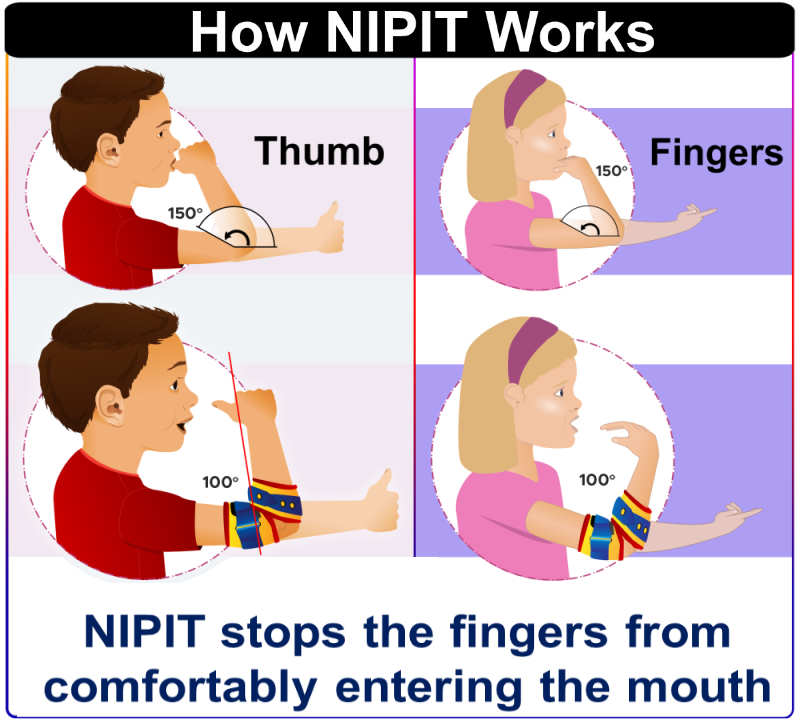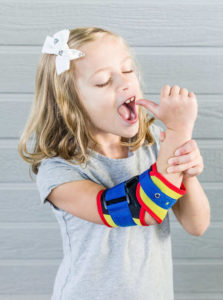
Why NIPIT is #1 by Dentists

Nipit is designed for children to stop oral fixations and unwanted hand-to-face habits. It is optimized to stop thumb sucking and is 100% effective when worn properly, because by design it prevents stops the thumb or fingers from comfortably entering the mouth. Its simple, hygienic design is effective – this simple reason is why it is recommended #1 by dentists.
The NIPIT Hand Stopper, also known as the thumb stopper, allows for total arm mobility until the elbow bends to about 100 degrees. Just past the mid bending point the Velcro-attached stopper acts as a brake between the fore- and upper-arm. On the inside, underneath the stopper is a soft cushion so that the stopper does not cause any pain to your child, but does apply firm pressure.

Nipit is essentially an optimized Ace bandage. Many dentists have recommended wrapping an Ace bandage around the elbow as a reminder, and which becomes more snug as the arm is bent because of the tendons on the inside of the elbow joint. The downside to the Ace bandage is that it is really difficult to put on the same each time, and not over or under tighten. Nipit solved that problem and enables you to consistently put it on the same way each time.

For the very stubborn child, there is an optional childproof locking system, called the easylock system. This system consists of zipties that loop through the holes in the straps and thereby lock the everything in place. To remove this optional system you’ll need scissors and a bit of hand cutting force, which is easy for a parent and difficult or impossible for most children who would need to do it with just one hand. Most the time, after having Nipit secured in place and not being able to take it off, the child agrees to wear it on their own.
With these design features, the device will 100% stop the thumb from comfortably reaching the mouth and it can be made so that the child cannot remove it.
It is comfortable and soft, and red-blue super-hero colored that kids actually like to wear. The base material is a neoprene, which is often used for athletic and adult elbow or knee medical supports. Quality is top-notch too. For these reasons, and because it is a better product, it is surprising that it costs less than the TGuard thumb guard. It is important for you to identify which product is best for your child, because they all have different needs when it comes to learning how to stop thumb sucking. Visit the main product review page to see a one-page comparison on products to stop thumb sucking.

At about the age of four years old the adult teeth begin erupting in the mouth. This is when it is absolutely critical to stop thumb sucking, otherwise your child can cause permanent damage, or at least damage that can result in thousands of dollars in costs with braces or even oral surgery. Many people do not realize the significant amount of damage and costs that comes from ignoring an otherwise fixable problem.

Did you know that over 90 percent of infants and babies suck their thumb? Thumb sucking is a natural, instinctual behavior for babies, and is useful for them to comfort themselves. Sometimes the habit forms as a replacement to the boob after being weened off. In other cases babies can be soothed to sleep with the thumb or finger, just like a blanky a little later in their young life. Thumb sucking is not only common, it is considered harmless in terms of a child’s growth… until it isn’t. The questions most parents ask themselves is, how long should it go on?
One of the most common questions is when is the best time to quit the thumb sucking habit? As soon as possible is the answer from most pediatricians, and definitely when the adult teeth begin coming in which is around age 4.
When you are seriously ready to attack the problem, treat it as a serious issue. Educate yourself and your child about the long-term detriments. Show them pictures such as the ones above. Create a program with your child. Create a reward system for them, get their buy-in so they are motivated – bribery works, and fortunately at this age bribes can cost only $10-$20. The long-term savings to you will be worth it.
